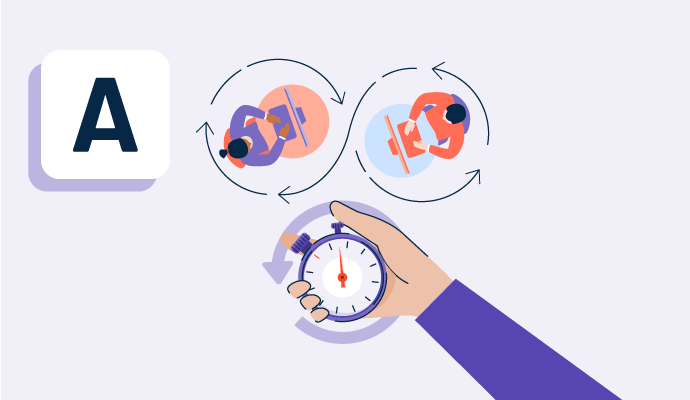O que é ágil?
Ágil é uma forma de prática de gerenciamento de projetos para fazer progressos incrementais em direção aos objetivos. Começou com equipes de desenvolvimento de software, mas muitas indústrias agora usam esse estilo de gerenciamento de trabalho.
Usando essa técnica, uma equipe completa o trabalho em ciclos curtos com feedback contínuo dos stakeholders. Ao contrário de uma abordagem tradicional de gerenciamento de projetos, o processo ágil enfatiza flexibilidade, colaboração e reflexão.
Muitas metodologias ágeis existem, incluindo scrum e kanban. Empresas que empregam um fluxo de trabalho no estilo kanban precisam de uma maneira visual para que os membros da equipe acompanhem as etapas do projeto. A ajuda visual pode vir na forma de um quadro kanban tangível ou software interativo de gerenciamento de projetos kanban. Plataformas de software têm o benefício adicional de permitir que as equipes acompanhem métricas como tempo de espera e tempo de ciclo.
Tipos de metodologias ágeis
Ágil é uma filosofia abrangente com um conjunto de valores e princípios que guiam uma equipe de projeto. Organizações ágeis escolhem entre várias metodologias ou frameworks que governam os processos diários de uma equipe. Três opções populares são:
- Scrum. É o framework ágil mais comumente usado para criar um produto ou atingir um objetivo em um segmento de uma a quatro semanas chamado sprint. Com a orientação de um scrum master, o grupo realiza quatro tipos diferentes de reuniões de check-in para planejar, compartilhar progresso, discutir realizações e refletir.
- Kanban. Kanban divide grandes objetivos em tarefas menores. Essas tarefas são exibidas em um quadro kanban com três colunas: "A Fazer", "Em Progresso" e "Concluído". Cada tarefa está em seu cartão no quadro kanban e se move para a coluna à direita à medida que um membro da equipe faz progresso com ela.
- Scrumban. Como o nome sugere, scrumban é uma combinação de scrum e kanban. Originalmente projetado como uma fase de transição para equipes que se movem de uma metodologia para outra, muitos grupos acham que a abordagem scrumban funciona bem para eles indefinidamente. Scrumban usa o processo iterativo e a estrutura de sprint do scrum, juntamente com elementos do kanban, como um quadro visual com cartões de tarefas individuais, chamado de quadro scrumban.
Benefícios do ágil
Ágil se tornou popular no desenvolvimento de software e gerenciamento de projetos como uma alternativa a abordagens mais rígidas e tradicionais. Empresas que usam ágil apreciam sua:
- Flexibilidade. Um dos princípios orientadores do ágil é responder à mudança em vez de seguir estritamente o plano original. Como as empresas ágeis dividem grandes projetos em partes menores, é mais fácil mudar de direção em qualquer fase do projeto. Essa estratégia mantém grandes organizações mais ágeis – mais rápidas para se adaptar a mudanças nos planos ou fatores externos.
- Tempo mais rápido para o mercado. As equipes ágeis refletem e iteram constantemente, o que as ajuda a otimizar seu fluxo de trabalho e diminuir o tempo de mercado (TTM) dos produtos, o tempo desde a concepção de um produto ou recurso até seu lançamento para os clientes.
- Melhor colaboração. Ao contrário do gerenciamento de projetos tradicional, que depende de liderança de cima para baixo, o ágil apresenta um processo altamente colaborativo. Os membros da equipe assumem responsabilidade coletiva para colaborar na solução de problemas. No scrum, um scrum master facilita a comunicação e resolve conflitos.
- Risco reduzido. Como uma equipe ágil completa o trabalho em ciclos curtos, uma empresa não precisa gastar grandes somas de dinheiro ou se comprometer com logísticas complexas.
- Taxas mais altas de satisfação do cliente. Equipes que usam ágil frequentemente apresentam trabalhos em andamento ao cliente, que então fornece feedback. As equipes ganham clareza sobre os valores do cliente e priorizam as tarefas de acordo.
Melhores práticas ágeis
Ágil ajuda equipes de produto e projeto a trazer bens ou serviços de maior qualidade ao mercado mais cedo. Para obter o máximo do ágil, as empresas devem se concentrar no seguinte:
- Construir equipes que trabalhem bem juntas. Alguns indivíduos trabalham melhor juntos do que outros. Os departamentos devem criar estrategicamente equipes ágeis com base nas habilidades que cada membro oferece e, em seguida, avaliar frequentemente a eficácia dessas formações. As empresas podem querer considerar exercícios de formação de equipe ou treinamento ágil para construir confiança ou habilidades de comunicação se uma equipe enfrentar conflitos.
- Manter o cliente em mente. Um dos valores primários do ágil é uma mentalidade centrada no cliente. Uma equipe ágil deve colaborar com os clientes ao longo do processo para obter feedback, fazer perguntas e entender os resultados desejados. Por exemplo, uma equipe de produto deve considerar a experiência do usuário (UX) e a experiência do cliente (CX) para aumentar a satisfação e a lealdade.
- Priorizar a comunicação presencial. As equipes ágeis se reúnem diariamente para discutir questões, esclarecer expectativas e refletir sobre os esforços. Para melhores resultados, essas reuniões, e quaisquer outras conversas que precisem acontecer, são realizadas face a face para que os indivíduos possam ler as dicas visuais de seus colegas de equipe. Mesmo em situações onde os membros da equipe de desenvolvimento estão trabalhando remotamente, eles devem optar por videoconferência em vez de conversas por telefone.
Veja estas ferramentas de colaboração de projetos para levar seu trabalho em equipe para o próximo nível.

Kelly Fiorini
Kelly Fiorini is a freelance writer for G2. After ten years as a teacher, Kelly now creates content for mostly B2B SaaS clients. In her free time, she’s usually reading, spilling coffee, walking her dogs, and trying to keep her plants alive. Kelly received her Bachelor of Arts in English from the University of Notre Dame and her Master of Arts in Teaching from the University of Louisville.




















